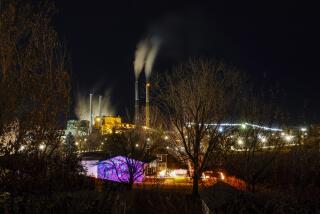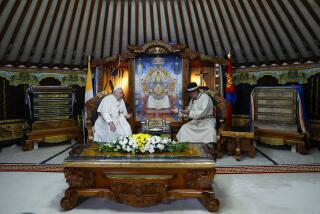Coal Colors Family’s Fortunes, Dreams in Post-Communist Mongolia
- Share via
NALAIKH, Mongolia — The lives of Jargal and her family are black with coal.
Coal collects in the creases in their burnished faces, gathers under their fingernails and pits their skin. Coal dust stiffens their hair and clothes. It shifts when a draft cuts across their stone floor.
For the family, coal is home: They live in the crumbling workings of a former state-run mine, eating, sleeping--even dreaming--among the spent, decaying hulks of an industrial center gone bust.
“Life in the countryside is better,” Jargal said one morning while gathering pieces of kindling wood and rubber strips for a fire. “If I didn’t have children, I would go to the country and be a herder.”
It’s the coal that keeps them in Nalaikh.
Like nearly everyone in the blighted town not far from Ulan Bator, Mongolia’s capital, Jargal and her husband, Alexander, eke out a living by scavenging coal from abandoned mine shafts and selling it, earning the equivalent of about $50 a month.
Most functions of the mine ground to a halt after the fall of Mongolia’s hard-line communist government in 1990, taking away the job Alexander thought he had for life.
Then the traditional ger tent the family lived in on the outskirts of Nalaikh started leaking. With no money to fix it, the family moved into one of the abandoned buildings at the mine the following year. Several families now live at the mine rent free.
Coal is at the center of their survival. It fires their crude stove. It pays for the flour and sheep innards they eat. It brings the money that allowed them to start sending their two boys--ages 8 and 12--to school in town just last year.
The family lives in two rooms on the first floor of a mine building, among hunks of generators and mining equipment too heavy to move out of the way. The toilet is a ditch behind another building.
Seeing the Good in Grim Surroundings
The fallen-down remains of the mine form a bombed-out backdrop to their lives. Their younger son has never lived anywhere but here, where chunks of brick and cement litter the ground and coal dust fills the air and dries the throat.
Signs of decay are everywhere. A twisted metal staircase leads nowhere. Goats graze in front of an office building with broken windows. Tangled steel railings lie in piles.
But Jargal manages to see some good in the grim surroundings. They have a solid roof over their heads, a steady source of income and electricity pirated from lines running over the mine.
“My boys’ childhood is better than mine,” she says in a raspy voice, coughing quietly and wiping a blackened hand across her brow in the morning sun. “I didn’t have pencils or paper, but with money, we can buy all these things.”
Jargal’s family lives in the ruins of Mongolia’s attempt to industrialize.
The Coal Mine of Mongolia was established in 1921, the same year the People’s Government of Mongolia took power with the backing of Russia’s Bolshevik regime. Mongolia became the world’s second communist nation three years later.
The mine powered steady growth in Nalaikh, 20 miles southeast of Ulan Bator. Mongolian Railway built its first line between the two in 1938.
Factories Employed Thousands in Heyday
Glass, brick and textile factories followed, employing thousands. Ethnic Kazaks--like Jargal and Alexander’s parents--were moved to Nalaikh from other parts of Mongolia by the government to provide labor at the mine and elsewhere.
Then the bottom fell out.
The coal mine was sold in 1992 to a private company, and locals say the new owners stripped the mine of usable machinery and shut the place down. Factory after factory in Nalaikh followed suit.
The town was devastated. Today, half of Nalaikh’s 22,000 people live in poverty, and estimates of unemployment and underemployment run as high as 68%. About 2,000 people dig illegally at the mine.
T. Enkhtaivan, governor of Nalaikh, has high hopes for the town, however. He says the industrial era has left the area with railroads and other infrastructure that could lure new business and investment.
On a hill overlooking town, work began in June on a sprawling oil refinery being built by a Chinese construction company for an estimated $230 million. Town officials expect the plant--the first oil refinery in Mongolia--to provide 1,800 jobs when it is finished in 2002.
Not everyone is convinced good times are ahead.
In town, the unemployed squat in the afternoon shadows, smoking cigarettes, chatting. And biding their time.
“All the young people and my friends are waiting for the oil refinery to have jobs,” says A. Tolobek, a 26-year-old father. “But I’m not so sure.”
At the coal mine, Jargal and Alexander say they have never heard of the oil refinery. Instead of dreams of the future, their days are taken up with nailing down the necessities of life: food, water, fuel.
Jargal’s day begins with fire. After getting the flame going with kindling and flammable rubber strips that fill the room with thick, biting smoke, she walks to a nearby mine shaft to gather chunks of coal.
She breaks them up with an ax and fits them into the fire, then heats water for tea and oil to fry bortsog, a flat roll that forms the mainstay of the family’s diet.
The two boys, who sleep together head to toe in a sagging steel bed, rise slowly in the smoke in their blackened clothes. They make games with the tools at hand: They wrestle, kick around a coin-shaped clump of steel, or pelt each other with the rocks that are everywhere.
Life amid coal is taking its toll. Jargal, who is in her 30s but looks 10 years older, says she has unspecified kidney problems, and she worries about the effect of coal smoke on the children’s health. Accidents at the decaying mines are a constant concern.
“I don’t see anything fun here,” says the older boy, Hasanbek. “When I listen to adults talk, they say they like it here--I don’t understand what’s so nice.”
After breakfast, Jargal does what she can to wipe the ubiquitous coal dust from the floor and the steel furniture in their rooms. She ladles water from a steel drum to wash her hands and face.
For more water, they trek about a mile to a communal waterspout in town. At midday, they head back to town to carry tea, hard cheese and bortsog to Alexander, 38, who is working on a construction project.
At night, Jargal boils sheep innards--intestines, kidneys, hearts--for dinner, while the children play outside in the ruins of the mine.
In between the business of survival, Jargal can only hope for her children. With schooling, she says, perhaps they’ll have a shot at the elusive keys to a better life: a profession and a steady job.
For her and her husband, however, she says the cards have already been dealt.
“People say there might be something new in our lives,” she says, the ash-gray mounds of the coal field stretching out behind her. “But I don’t really think our lives are going to change soon.”
*
On the Net, Mongolia news site:
https://www.MongoliaOnline.mn
More to Read
Sign up for Essential California
The most important California stories and recommendations in your inbox every morning.
You may occasionally receive promotional content from the Los Angeles Times.










